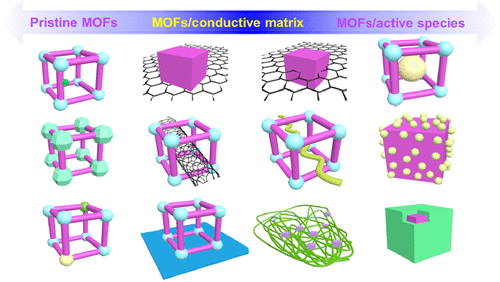Our official English website, www.x-mol.net, welcomes your
feedback! (Note: you will need to create a separate account there.)
Advanced Electrocatalysts Based on Metal-Organic Frameworks.
ACS Omega ( IF 3.7 ) Pub Date : 2019-12-30 , DOI: 10.1021/acsomega.9b03295 Fuqin Zheng 1, 2 , Ziwei Zhang 1, 3 , Chunmei Zhang 4 , Wei Chen 1, 3
ACS Omega ( IF 3.7 ) Pub Date : 2019-12-30 , DOI: 10.1021/acsomega.9b03295 Fuqin Zheng 1, 2 , Ziwei Zhang 1, 3 , Chunmei Zhang 4 , Wei Chen 1, 3
Affiliation

|
In recent years, metal-organic frameworks (MOFs) have been wildly studied as heterogeneous catalysts due to their diversity of structures and outstanding physical and chemical properties. Meanwhile, MOFs have also been regarded as promising templates for the synthesis of conductive and electrochemically active catalysts. However, in most of the studies, high-temperature annealing is needed to transform nonconductive or low-conductive MOFs to conductive materials for electrocatalyis, during which the unique structures and intrinsic active sites in MOFs can be easily destroyed. Therefore, in recent years, different strategies have been developed for improving the catalytic performances of MOF-based composites for electrochemical reactions with no need of post-treatment. This mini-review highlights the recent advances on MOF-based structures with improved conductivities and electrochemical activities for the application in electrocatalysis. Overall, the advanced MOF-based electrocatalysts include the highly conductive and electrochemically active pristine MOFs, MOFs combined with conductive substrates, and MOFs hybridized with active materials. Finally, we propose the direction for future works on MOF-based electrocatalysts.
中文翻译:

基于金属有机骨架的高级电催化剂。
近年来,由于金属有机骨架(MOFs)结构的多样性以及出色的物理和化学特性,它们被广泛用作非均相催化剂。同时,MOF也被认为是合成导电和电化学活性催化剂的有前途的模板。但是,在大多数研究中,需要高温退火才能将非导电或低导电的MOF转变为用于电催化的导电材料,在此期间,MOF中的独特结构和固有活性位点很容易被破坏。因此,近年来,已经开发了不同的策略来改善基于MOF的复合材料的电化学反应的催化性能,而无需进行后处理。这篇小型综述着重介绍了基于MOF的结构的最新进展,该结构具有改进的电导率和电化学活性,可用于电催化。总体而言,先进的基于MOF的电催化剂包括高导电性和电化学活性的原始MOF,与导电基质结合的MOF以及与活性材料混合的MOF。最后,我们提出了基于MOF的电催化剂未来工作的方向。
更新日期:2020-02-18
中文翻译:

基于金属有机骨架的高级电催化剂。
近年来,由于金属有机骨架(MOFs)结构的多样性以及出色的物理和化学特性,它们被广泛用作非均相催化剂。同时,MOF也被认为是合成导电和电化学活性催化剂的有前途的模板。但是,在大多数研究中,需要高温退火才能将非导电或低导电的MOF转变为用于电催化的导电材料,在此期间,MOF中的独特结构和固有活性位点很容易被破坏。因此,近年来,已经开发了不同的策略来改善基于MOF的复合材料的电化学反应的催化性能,而无需进行后处理。这篇小型综述着重介绍了基于MOF的结构的最新进展,该结构具有改进的电导率和电化学活性,可用于电催化。总体而言,先进的基于MOF的电催化剂包括高导电性和电化学活性的原始MOF,与导电基质结合的MOF以及与活性材料混合的MOF。最后,我们提出了基于MOF的电催化剂未来工作的方向。











































 京公网安备 11010802027423号
京公网安备 11010802027423号